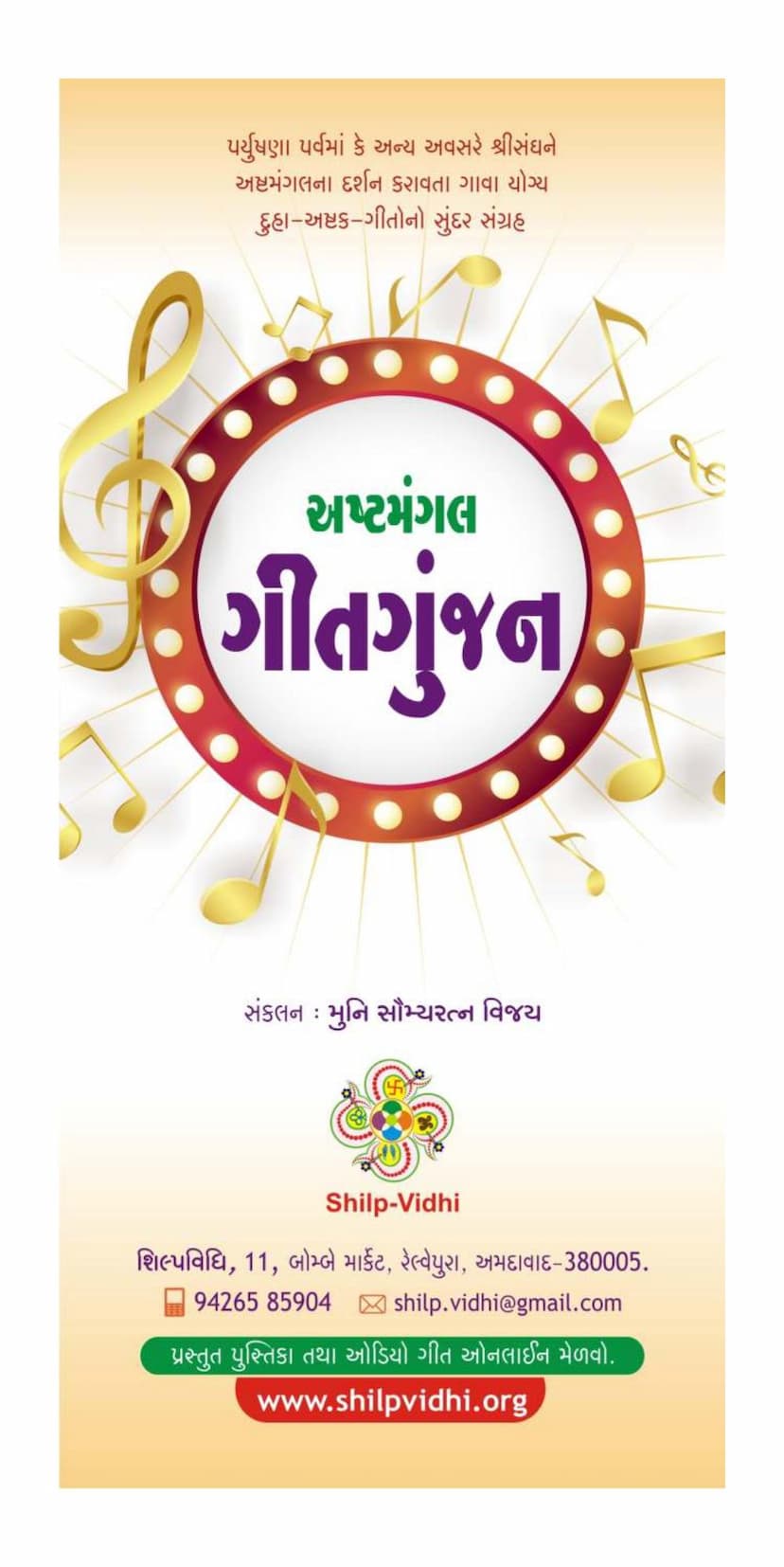Ashtmangal Geet Gunjan
Added to library: September 1, 2025

Summary
This Jain text, "Ashtmangal Geet Gunjan" by Saumyaratnavijay and published by Shilpvidhi Prakashan, is a collection of songs, verses (duhas), and hymns designed to be sung during the Paryushan festival or other auspicious occasions for the benefit of the Jain community (Shri Sangh). The primary focus of the book is on the "Ashtamangals," which are the eight auspicious symbols in Jainism.
Here's a comprehensive summary of the content across the provided pages:
Overall Purpose and Theme: The book aims to explain the significance and auspiciousness of the eight Jain Ashtamangals. It provides a way for the Jain community to experience, understand, and celebrate these symbols, believing that their presence and recitation bring blessings, prosperity, and spiritual progress. The text emphasizes the role of these symbols in dispelling inauspiciousness (amangal) and promoting well-being (mangal) for individuals, the community, and the world.
Key Components and Structure:
- Introduction of Ashtamangals (Page 3): The book begins by listing the eight Ashtamangals and offering a short, descriptive verse (duha) for each. These verses highlight the specific benefits and meanings associated with each symbol.
- Swastik: Represents prosperity, success, and the overcoming of obstacles in the cycle of birth and death.
- Shrivatsa: Associated with Lakshmi (goddess of wealth), bringing happiness and prosperity.
- Nandavarta: Dispels the cycle of rebirth and brings eternal bliss.
- Vardhamanaka: Symbolizes continuous growth in merit, fame, and authority, promoting the increase of dharma.
- Bhadrasana (or Bhadraasana): Bestows auspiciousness, happiness, and the granting of the kingdom of the soul through its darshan (sight).
- Purnakalash (Full Pot): Fulfills material and spiritual desires, leading to liberation.
- Meena Yugal (Pair of Fish): Represents devotion to the Lord, akin to fish needing water, and fosters a pure mind.
- Darpan (Mirror): Aids in overcoming pride and ego, leading to the realization of the soul's true, pure nature through self-reflection.
- Significance and Scriptural Basis (Page 4): This section emphasizes that the Ashtamangals are eternal and have been mentioned in Jain scriptures (Jainagamas). It states their presence in divine realms, on the doors of celestial vehicles (vimanas), and in eternal Jain temples. The text also mentions their use during the processions of powerful figures like Chakravartis and in the context of significant Jain figures' lives. It highlights that each Ashtamangal has 17 unique qualities described in the scriptures.
- Scriptural Reference (Page 5): A direct quote from the Rayapaseniya Sutra is provided, describing the Ashtamangals as being made of all gems, pure, smooth, polished, free from dust and blemishes, radiant, and pleasing to behold. This passage further elaborates on the sublime qualities of these auspicious symbols.
- Detailed Hymns for Each Ashtamangal (Pages 6-15): The core of the book consists of hymns (geet) composed by P.P.A.Bh. Shri Kalyansurishwarji M.Sa. and others, dedicated to each of the eight Ashtamangals. Each hymn:
- Introduces the Ashtamangal with its name and significance.
- Often references scriptural or traditional contexts (e.g., Indra's wives decorating with them, their placement before the Lord, their association with specific Tirthankaras).
- Explains the benefits of venerating the symbol (e.g., overcoming cycles of birth, gaining wealth, achieving peace, increasing merit, attaining liberation).
- Includes a mantra for each Ashtamangal, typically a Navkar Mantra variation with specific invocations for peace, prosperity, and well-being for the Jain community.
- Features devotional songs (in various ragas like "Sathiyapuraavo Aaj," "Mehendi Laagyo," "Mara Dadaane Darbare," "Ame Gyaan Deare," "Siddhachal Shikhare," "Jhamagmagta Tarlaanu," "Tildadi Re Mara," "Leta Mara Prabhuji Nu") that are to be sung with joyous celebration while presenting each Ashtamangal.
- The Role of the Community (Shri Sangh): The book repeatedly stresses that the chanting and presentation of these Ashtamangals are for the collective well-being of the Shri Sangh (the Jain congregation) and the entire world. The blessings invoked are for "Sakal Shri Jain Sangh" (the entire Jain community) and "Vishwamatra" (the entire universe).
In essence, "Ashtmangal Geet Gunjan" serves as a devotional guide for Jain communities to connect with and draw spiritual and material benefits from the sacred eight auspicious symbols. It combines scriptural knowledge with devotional music and chants to create an immersive experience of auspiciousness and spiritual upliftment, particularly during important religious observances.